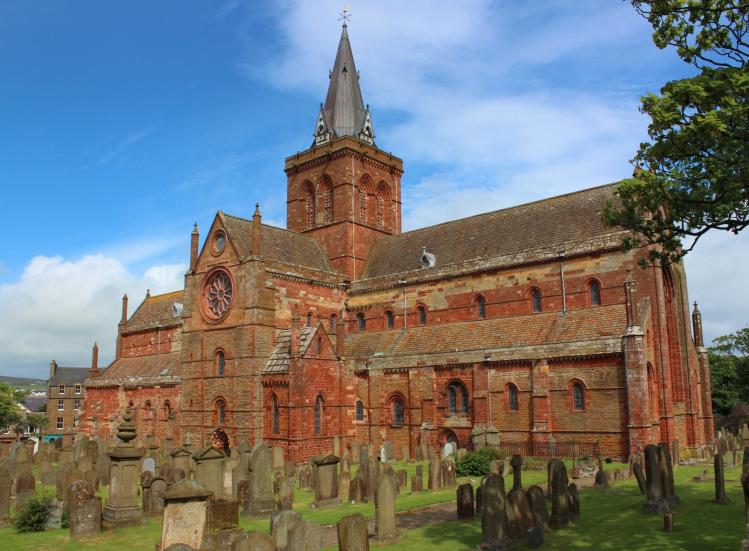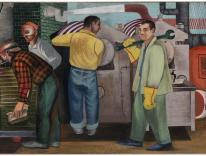
In September of 2003, I took a trip to Scotland with Commonweal’s longtime contributor and movie critic Rand Cooper. As it happens, Rand and I are good friends, having known each other since we were both teachers in a private country-day school in New London, Connecticut, in the early 1980s. It is remarkable how little we have changed physically since those days, or at least that is what we keep telling each other. Actually, that is true only for one of us. The other guy looks like something from the Stone Age.
At the time of our trip, Rand was on assignment for Bon Appétit, where he served as a contributing writer for many years. As a travel and food writer, he was sent to glamorous spots around the globe, from Portugal and Berlin to the Caribbean as well as all over the United States. On our travels we first visited the lush Isle of Skye on the western edge of Scotland, then drove many hours north to the Orkneys before returning south to Edinburgh. I got to tag along with Bon Appétit’s most fearless eater because Molly, Rand’s wife, was teaching school.
The Orkneys were the most memorable part of the trip, at least as far as I was concerned. The islands—there are seventy, most of them uninhabited—possess what is usually called a “stark” beauty, and if you are drawn to wind-swept and somewhat desolate landscapes, where the moods of the ocean and the sky seem to mirror one another, then this far northern archipelago can’t be recommended strongly enough. The islands are low-lying, and thanks to the Gulf Stream, the climate is mild. The fertile soil provides ample grazing for sheep and cattle. Perhaps most intriguing, the Orkneys are honeycombed with Neolithic ruins, evidence of the sometimes unsurprising contours and preoccupations of human society as much as five thousand years ago. On the Orkneys you literally step into the distant past when you visit Skara Brae, on the island known as the “Mainland,” an excavated village replete with an unexpectedly familiar domestic floorplan, from kitchens to bedrooms. Not far from Skara Brae is the Ring of Brodgar, a circular monument of twenty-seven monoliths set between two lochs, a kind of miniature Stonehenge. Legend has it that to circle the ring three times increases the chances of successfully conceiving a child. Heathen that he is, Rand jogged the required distance. Evidently there is something efficacious to the ritual, since the Coopers’ daughter is now twelve years old and has the blond hair, rosy complexion, and fearless disposition of the Vikings who invaded the Orkneys in the 800s.
A recent article in the New York Times reports that Orkney’s ancient ruins are now endangered by the encroaching ocean, thanks to the inexorable pace of climate change (“Rising Seas Lap at Heritage in Scotland,” September 29). According to the Times, there are three thousand Neolithic sites on the islands, half of which are now threatened by the rising sea. Little can be done to save most of these. Teams of archaeologists, students, and government agencies are building barriers to the ocean where possible, but can do little more than document the existence of other ruins.
Perhaps the most evocative site we visited was Maeshowe, a circular stone tomb built in 3000 BC. You enter through a narrow and claustrophobic passageway. That crawlspace was painstakingly built so that, on the winter solstice, the sun shines directly into the burial chamber. One can only imagine what aspirations for the dead were in the minds of the builders.
Kirkwall, the capital of Orkney and its biggest town, is also on the Mainland. St. Magnus Cathedral, a beautiful Romanesque structure, begun in 1137 and completed three hundred years later, dominates the otherwise modest town skyline. St. Magnus seems to have met a violent end, as did many of the other medieval figures buried in the church. When first built, the cathedral was under the purview of a Norwegian bishop, but eventually ended up in the hands of the Church of Scotland thanks to the Reformation. At various times over its long history the Orkneys have been conquered by Norsemen, Norwegians, Romans, Scots, and Brits, as well as the aforementioned Vikings.
Just as interesting in its way, if nowhere near as grand as the cathedral, is the “Italian Chapel” on the small island of Lamb Holm. The chapel, put together during World War II by Italian prisoners of war using two Nissen huts, is elaborately decorated, all of the art work done by the prisoners. Nearly every inch of the interior has been turned into a faux Italian parish church, with a painting of the Blessed Virgin holding the baby Jesus dominating the wall above the small altar and tabernacle. The chapel was by necessity a modest but still impressive act of piety and longing, and has been reverently restored several times in the decades since the war.
The Italian Chapel and the Maeshowe burial chamber are separated by millennia, and yet seem complementary, if not connected in some primitive and aspirational way. They share, it seems to me, the human instinct that almost everywhere compels us to build sanctuaries that somehow capture—or, if not capture, at least consecrate—the fleeting and ungraspable nature of both life and time. These worship sites were built with the most humble of materials, and yet both have somehow survived, at least for now. One wonders if our technological civilization, so daunting in its accomplishments and yet so unconcerned about our place in the larger order of things, will leave anything as palpably human after the oceans sweep away these ancient memorials, and then our towering cities of steel and glass.
Please email comments to [email protected] and join the conversation on our Facebook page.
Previous Story
The Church That Has to Come
Next Story
From the Archives: Ratzinger, Gutierrez, and the bishops of Peru
